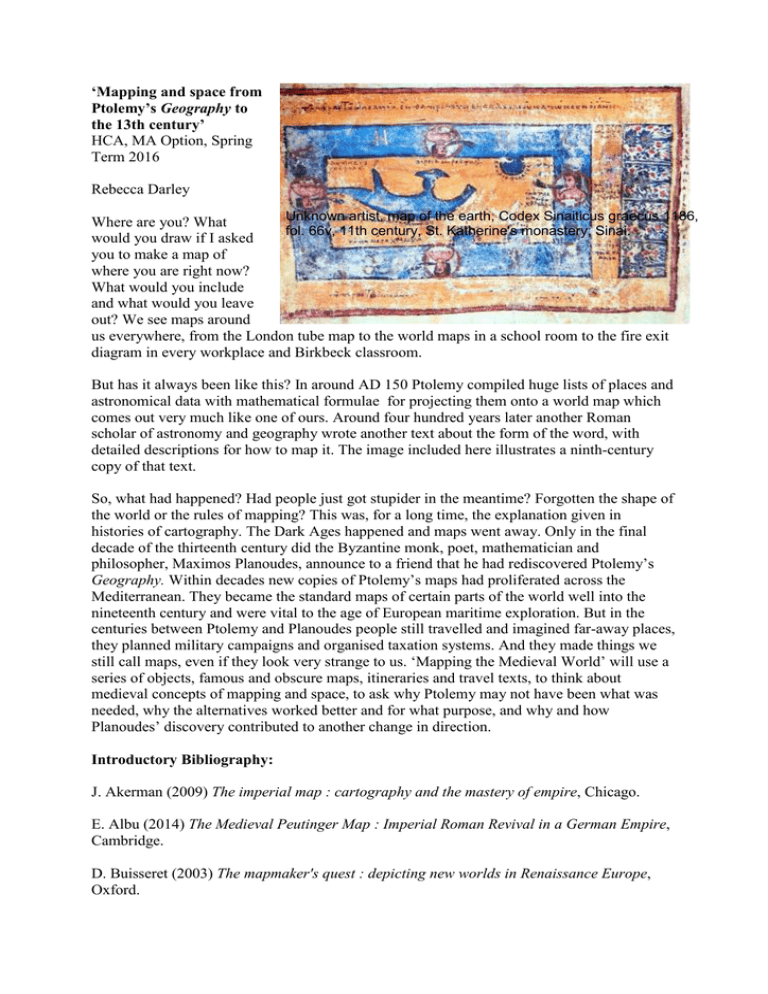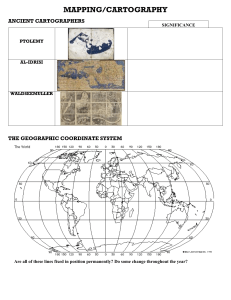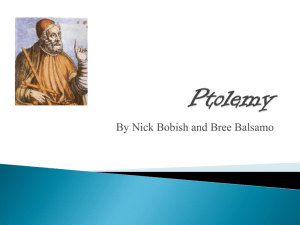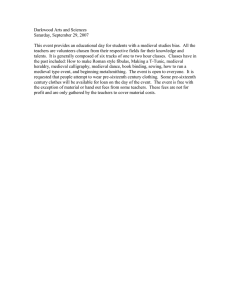`Mapping and space from Ptolemy`s Geography to the 13th century
advertisement

‘Mapping and space from Ptolemy’s Geography to the 13th century’ HCA, MA Option, Spring Term 2016 Rebecca Darley Unknown artist, map of the earth, Codex Sinaiticus graecus 1186, Where are you? What fol. 66v, 11th century, St. Katherine's monastery, Sinai. would you draw if I asked you to make a map of where you are right now? What would you include and what would you leave out? We see maps around us everywhere, from the London tube map to the world maps in a school room to the fire exit diagram in every workplace and Birkbeck classroom. But has it always been like this? In around AD 150 Ptolemy compiled huge lists of places and astronomical data with mathematical formulae for projecting them onto a world map which comes out very much like one of ours. Around four hundred years later another Roman scholar of astronomy and geography wrote another text about the form of the word, with detailed descriptions for how to map it. The image included here illustrates a ninth-century copy of that text. So, what had happened? Had people just got stupider in the meantime? Forgotten the shape of the world or the rules of mapping? This was, for a long time, the explanation given in histories of cartography. The Dark Ages happened and maps went away. Only in the final decade of the thirteenth century did the Byzantine monk, poet, mathematician and philosopher, Maximos Planoudes, announce to a friend that he had rediscovered Ptolemy’s Geography. Within decades new copies of Ptolemy’s maps had proliferated across the Mediterranean. They became the standard maps of certain parts of the world well into the nineteenth century and were vital to the age of European maritime exploration. But in the centuries between Ptolemy and Planoudes people still travelled and imagined far-away places, they planned military campaigns and organised taxation systems. And they made things we still call maps, even if they look very strange to us. ‘Mapping the Medieval World’ will use a series of objects, famous and obscure maps, itineraries and travel texts, to think about medieval concepts of mapping and space, to ask why Ptolemy may not have been what was needed, why the alternatives worked better and for what purpose, and why and how Planoudes’ discovery contributed to another change in direction. Introductory Bibliography: J. Akerman (2009) The imperial map : cartography and the mastery of empire, Chicago. E. Albu (2014) The Medieval Peutinger Map : Imperial Roman Revival in a German Empire, Cambridge. D. Buisseret (2003) The mapmaker's quest : depicting new worlds in Renaissance Europe, Oxford. E. Edson (1999) Mapping time and space : how medieval mapmakers viewed their world, London. J. B. Harley and D. Woodward (eds) (1992) Cartography in the traditional Islamic and South Asian societies, Chicago. K. Lilley (2013) Mapping Medieval Geographies : Geographical Encounters in the Latin West and Beyond, 300–1600, Cambridge.





